
CHRISTOPHER CRUISE: This is SCIENCE IN THE NEWS, in VOA Special English. I'm Christopher Cruise.
BOB DOUGHTY: And I'm Bob Doughty. Today, we tell about evidence of liquid water on the planet Mars. We also consider a theory that the Earth once had a small second moon. And we celebrate summertime with a report about creatures known to light up the night sky.
(MUSIC)
CHRISTOPHER CRUISE: An American spacecraft orbiting Mars shows it is possible that the planet could someday support human life. The Mars Reconnaissance Orbiter has found the best evidence yet that liquid water flows on Mars during the planet's warm season.
Charles Bolden heads the National Aeronautics and Space Administration. He says NASA's Mars Exploration Program keeps bringing scientists closer to learning if Mars could support some form of life. He says the program has shown that the planet is an important goal for future human exploration.
BOB DOUGHTY: The Mars Reconnaissance Orbiter studied many mountain slopes across the planet's southern hemisphere. The dark lines of mountain sides are said to look like fingers. The marks appear and disappear with the seasons.
The marks appear when temperatures on Mars rise. They look larger as they go downhill. When it gets cold, these streaks disappear. But they are seen again on the planet during the next spring, or warming season.
CHRISTOPHER CRUISE: Alfred McEwen is lead investigator for the orbiter's High Resolution Imaging Science Experiment. He also is a professor of planetary geology at the University of Arizona in Tucson. Professor McEwen says a flow of briny, or salty, water is the best explanation for the orbiter's observations. Other spacecraft and Martian meteorites have shown that the Martian surface is salty.
The professor says the water on Mars may differ from that found on Earth. He says the Mars water might be more like a thick fluid. "Science" magazine published a report about the orbiter's findings.
BOB DOUGHTY: Professor McEwen and his team believe that water probably flowed across ancient Mars. But whether water exists as a liquid on the Red Planet can still be debated. The iron oxide on Mars gives the planet its reddish color.
Philip Christensen is an expert in geological science at Arizona State University. He says scientists have known for years that ice existed on Mars.
PHILIP CHRISTENSEN: "We know Mars has a lot of ice. But this is the first time we have seen the potential for liquid water. It might be salty water. But it is still liquid. And I think that is the real key here. It is not that Mars does not have a lot of ice. But liquid water – certainly to an organism – is very, very very different than ice."
Geology expert Lisa Pratt of Indiana University welcomes the research results. She says the discovery will help scientists plan future travels to look for life signs on present-day Mars.
(MUSIC)
CHRISTOPHER CRUISE: "Blue moons, you saw me standing alone." The cow jumped over the moons. "Shine on Harvest Moons." These expressions sound unusual. Why the choice of "moons" and not just "moon?" There is only one moon, right? Yes, there is only one, but long ago there might have been two!
American and Swiss researchers say the Earth may once have had a big moon, the one that is still there, and a little moon. And then, about four billion years ago, they hit each other. The little moon exploded into rock and dust, and much of it landed on the dark side of the larger moon. The researchers call it the "big splat."
Scientists from the University of California at Santa Cruz and the University of Bern reported their findings in "Nature" magazine. The scientists say the little moon was very small, only about 1,200 kilometers across. They say the little moon and the big moon were just fine together for 100 million years. Then something happened and the little moon lost the battle.

BOB DOUGHTY: The Earth and the moon turn in a way that keeps the dark side of the moon away from us. From earth, we see only one side. But we know what the other side looks like. Spacecraft have taken many pictures of the dark side. Those pictures show that the side of the moon we see is a lot different from its other side.
Our side has ridges or hills, and craters, some of them deep. But it is not nearly so "bumpy" as the dark side. Researchers think this is because the little moon crashed, fell apart, and landed on the other side. They say the dark side has a thick upper layer of soil. It also has much higher mountains than on the side we see. Some of them are 3,000 meters high. And when the little moon hit the big moon, it caused a bulge. The other side of the moon sticks out into space more. Think of a children's ball that has been hit or kicked too much. That ball, and our moon, are no longer round. They are lop-sided. Pictures of the dark side clearly show this.
CHRISTOPHER CRUISE: You may be wondering how our moon got there in the first place. Scientists think it also resulted from a crash. Billions of years ago, they say, something very large hit the earth. It may have been as big as the planet Mars. When that happened, part of the earth was thrown out into space. Over time, these pieces of earth-rock and dust came together, and formed not one, but two moons.
The American space agency plans to explore the moon further within the next year. That may help to prove the two-moon crash idea, or maybe offer something completely new. But if the latest research is correct, what is now one, was once two!
(MUSIC)
JIM TEDDER: It is a summer night in America. A father and mother are reading the newspaper and listening to the radio. The children are outside, playing and waiting for a special time. Then, just as it starts to get very dark, the magic begins.
CHILD'S VOICE: "Look (blip) there's one over there ... (blip) and another over there! Look (blip blip blip) three more ... up near the tree. Let's catch 'em."
BOB DOUGHTY: What they were trying to catch and put into a glass jar are coleoptera: flying beetles better known as "fireflies" or "lightning bugs."
Scientists say there are about 2,000 kinds of these insects. Most are brown. Each is only about a centimeter long. Fireflies have wings folded over their backs. When they fly, they do so in an unusual way. Some people say they fly in the shape of the letter "J." That means they fly horizontally, then drop quickly, only to rise again. But the most surprising thing about these little creatures is that they make light.
They do this by the process known as bioluminescence. Oxygen mixes with chemicals in the body of the lightning bug. Then, for a second, its belly lights up. Some produce a flash of yellow light. Others appear green or red. But why do they do this?

CHRISTOPHER CRUISE: Entomologists, people who study insects, think the flashing light is an invitation to have sex. They believe the male firefly is making a signal to a female waiting in the grass. He is saying, "Look, here I am. Let's get together." If the female agrees, she will answer with a flash of her own. Studies at the University of Kansas have shown that females like males who can flash the fastest.
In some parts of the world, fireflies act in an amazing way. Thousands of them flash their light on and off at the same time. This can often be seen in Malaysian jungles and in the American states of Tennessee and South Carolina.
Scientists do not know how lightning bugs are able to communicate with each other to do this. But they think it is either a call for sex, or a warning sign from the bugs to their enemies. Insects with lights carry chemicals that do not taste good. Some of those chemicals, however, are useful to people. Health researchers use them in the study of cancer, heart disease, multiple sclerosis, and cystic fibrosis.
BOB DOUGHTY: Fireflies live for about three years. Most of that time is spent in the ground as larvae. Some people call it a "glow worm" before it becomes a flying adult. And yes, glow worms ... larvae ... do, indeed, glow. Scientists say these little bugs only come out in warm weather, and only at night. During the day, they hide on the ground or in trees or other plants.
Wherever there is light, there is heat. A common light bulb wastes 90 percent of the energy it uses in the form of heat. But a lightning bug produces "cold light." That means that most of its flash is true light. Only about three percent of its energy comes as heat.
After three years, the life of a lightning bug's life is done. The females bury their eggs in the ground, and the birth and death cycle starts all over again, just as it has for millions of years.
JIM TEDDER: Summertime in America: ice cream, baseball games, and, yes, (blip blip blip) fireflies at the close of another day.
(MUSIC)
CHRISTOPHER CRUISE: This SCIENCE IN THE NEWS was written by Jerilyn Watson and Jim Tedder, who you also heard on our program. Our producer was June Simms. I'm Christopher Cruise.
BOB DOUGHTY: And I'm Bob Doughty.Visit us at voaspecialenglish.com, where you can find transcripts and MP3s of our reports. Join us again next week for more news about science in Special English on the Voice of America.
meteorite: 隕石;流星
coleoptera: 鞘翅目,昆蟲中最大的家族,這類昆蟲的第一對翅硬化成翅鞘,以保護身體和用以飛行時的后翅
cystic fibrosis: 囊胞性纖維癥
Scientist: 'Alien' life forms on meteorites
(來源:VOA 編輯:崔旭燕)
